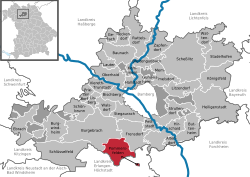Pommersfelden | |
|---|---|
 | |
Location of Pommersfelden within Bamberg district  | |
| Coordinates: 49°46′N10°49′E / 49.767°N 10.817°E | |
| Country | Germany |
| State | Bavaria |
| Admin. region | Oberfranken |
| District | Bamberg |
| Subdivisions | 10 Gemeindeteile |
| Government | |
| • Mayor (2020–26) | Gerd Dallner [1] |
| Area | |
• Total | 35.71 km2 (13.79 sq mi) |
| Elevation | 270 m (890 ft) |
| Population (2024-12-31) [2] | |
• Total | 3,102 |
| • Density | 87/km2 (220/sq mi) |
| Time zone | UTC+01:00 (CET) |
| • Summer (DST) | UTC+02:00 (CEST) |
| Postal codes | 96178 |
| Dialling codes | 09548, 09502 |
| Vehicle registration | BA |
| Website | www.pommersfelden.de |

Pommersfelden is a municipality in the Upper Franconian district of Bamberg in Germany.




